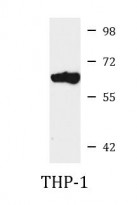ARG57949
anti-ENOX2 antibody
anti-ENOX2 antibody for ICC/IF,Western blot and Human,Mouse,Rat
Overview
| Product Description | Rabbit Polyclonal antibody recognizes ENOX2 |
|---|---|
| Tested Reactivity | Hu, Ms, Rat |
| Tested Application | ICC/IF, WB |
| Host | Rabbit |
| Clonality | Polyclonal |
| Isotype | IgG |
| Target Name | ENOX2 |
| Antigen Species | Human |
| Immunogen | Recombinant fusion protein corresponding to aa. 411-610 of Human ENOX2 (NP_872114.1). |
| Conjugation | Un-conjugated |
| Alternate Names | APK1; EC 1.-.-.-; APK1 antigen; Ecto-NOX disulfide-thiol exchanger 2; COVA1; Tumor-associated hydroquinone oxidase; Cytosolic ovarian carcinoma antigen 1; tNOX |
Application Instructions
| Application Suggestion |
|
||||||
|---|---|---|---|---|---|---|---|
| Application Note | * The dilutions indicate recommended starting dilutions and the optimal dilutions or concentrations should be determined by the scientist. | ||||||
| Positive Control | THP-1 | ||||||
| Observed Size | ~ 65 kDa |
Properties
| Form | Liquid |
|---|---|
| Purification | Affinity purified. |
| Buffer | PBS (pH 7.3), 0.02% Sodium azide and 50% Glycerol. |
| Preservative | 0.02% Sodium azide |
| Stabilizer | 50% Glycerol |
| Storage Instruction | For continuous use, store undiluted antibody at 2-8°C for up to a week. For long-term storage, aliquot and store at -20°C. Storage in frost free freezers is not recommended. Avoid repeated freeze/thaw cycles. Suggest spin the vial prior to opening. The antibody solution should be gently mixed before use. |
| Note | For laboratory research only, not for drug, diagnostic or other use. |
Bioinformation
| Database Links |
Swiss-port # Q16206 Human Ecto-NOX disulfide-thiol exchanger 2 Swiss-port # Q8R0Z2 Mouse Ecto-NOX disulfide-thiol exchanger 2 |
|---|---|
| Gene Symbol | ENOX2 |
| Gene Full Name | ecto-NOX disulfide-thiol exchanger 2 |
| Background | This gene is a tumor-specific member of the ECTO-NOX family of genes that encode cell surface NADH oxidases. The encoded protein has two enzymatic activities: catalysis of hydroquinone or NADH oxidation, and protein disulfide interchange. The protein also displays prion-like properties. Alternative splicing results in multiple transcript variants. [provided by RefSeq, Aug 2013] |
| Function | May be involved in cell growth. Probably acts as a terminal oxidase of plasma electron transport from cytosolic NAD(P)H via hydroquinones to acceptors at the cell surface. Hydroquinone oxidase activity alternates with a protein disulfide-thiol interchange/oxidoreductase activity which may control physical membrane displacements associated with vesicle budding or cell enlargement. The activities oscillate with a period length of 22 minutes and play a role in control of the ultradian cellular biological clock. [UniProt] |
| Cellular Localization | Cell membrane, Secreted, extracellular space. [UniProt] |
| Calculated MW | 70 kDa |
| PTM | Glycosylated. [UniProt] |
Images (1) Click the Picture to Zoom In






